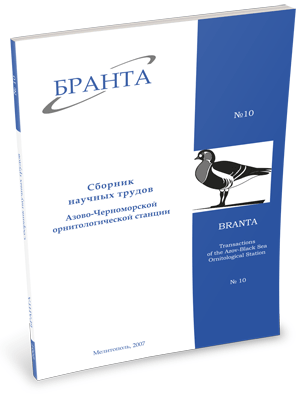
Transactions
of the Azov-Black Sea Ornithological Station



Numbers and habitat distribution of Whinchat and Common Stonechat in North-eastern and Eastern Ukraine
M.V.Banik
The numbers and habitat distribution of Whinchat (Saxicola rubetra) and Common Stonechat (S. torquata) were analysed for the great part of their ranges’ overlap in North-eastern and Eastern Ukraine. Within the area Common Stonechat is a newcomer that colonised it rapidly in 1960s-1970s. The data on the numbers (breeding density and share in overall bird community structure) and habitat distribution for both species were collected with use of transect count method in Sumy, Kharkiv, Lugansk and Donetsk regions in forest-steppe and steppe zones in 1991-2003 years. The total length of transects was 284.9 km. The survey covered all main types of open habitats including meadows of various types and bogs, meadow steppe on slopes, chalk steppe on slopes, plain steppe, sand steppe, crops and fallow lands, and some others. The Whinchat numbers exceeded the numbers of Common Stonechat 3-5 times in every studied habitat even in most favourable for the latter species (chalk steppe). The differences are highly reliable in any case (Wilcoxon test, Mann-Whitney test) and may be presumably attributed to marked requirement of Common Stonechat in vast breeding territories. The mean breeding density of Whinchat in majority of studied habitats is about 2.5 pairs/10 ha. The numbers are higher (3.8-4.3 pairs/10 ha) in optimal habitats (meadow steppe on slopes, meadows in small river flood-plains) owing to the combination of available nesting and feeding sites as well as plenty of perches. In sub-optimal habitats (sand steppe, salt meadows, crops and fallow lands) the breeding density of Whinchat drops to 0.4-0.8 pairs/10 ha due to lack of suitable nesting sites. Whinchat is a typical dominant species possessing 5 to 20% of overall numbers in breeding bird communities of open habitats in surveyed area. The mean breeding density of Common Stonechat in optimal habitats (chalk steppe, meadows in small river flood-plains) is 0.3-0.35 pairs/10 ha. The maximum numbers were registered for chalk steppe on slopes (0.7 pairs/10 ha) which resemble primary habitats of the species in Mediterranean. Comparatively high density in meadows within small river flood-plains is due to spread of mesic conditions after introducing drainage practice in 1960s. The mean share of Common Stonechat in bird community structure is usually about 1% while the maximum recorded rarely exceeded 5%. The pattern in habitat distribution of Whinchat may be partly explained by the species requirements in habitat structure e.g. availability of nesting sites, presence of sites with sparse and low vegetation cover, and availability of perches (stems of perennial herbs). Apart of the mentioned factors Common Stonechat’s distribution depends on relief and vegetation heterogeneity and spring flood duration in meadow habitats.
Read the paper in a PDF file